Introduction: Portal vein thrombosis is an embolism that occurs in the extrahepatic portal system. The causes of PVT include liver cirrhosis, intra-abdominal infection, portal system damage, coagulation dysfunction, and oral contraceptives. Patients will have fever, chills, abdominal pain, low back pain, abdominal distension, diarrhea and other symptoms. The prognosis of the disease is related to its cause, and death can occur in severe cases. What are the signs and symptoms of abdominal pain

1. After the disease, what symptoms usually appear? The following symptoms need more attention
Overview of symptoms
Patients with low back pain, abdominal pain, abdominal distension, fever, chills, blood in the stool, diarrhea, black stools, some mild patients may have no obvious symptoms. There are some differences in the performance of acute and chronic PVT.
Characteristic symptoms
1: Acute PVT
A. Abdominal pain
Rapid and complete occlusion of the portal or mesenteric veins of the intestinal venous arches without involving the mesenteric veins can result in intestinal congestion, which manifests as severe persistent abdominal cramps, sometimes with bloodless diarrhea.
Transmural intestinal ischemia and intestinal necrosis may present with persistent severe abdominal pain, which may radiate to the back after 5 to 7 days, accompanied by bloody diarrhea and ascites. Occurrence of this disease can lead to intestinal perforation, peritonitis, shock and death from multiple organ failure.
B. Fever
Systemic inflammatory response is characterized by persistent, non-peak fever; acute septic PVT (acute portal phlebitis) is clinically manifested by a peak fever with chills, liver pain, and sometimes shock, and sepsis-related symptoms of cholestasis. Others: The patient will also have symptoms such as abdominal distension and gastrointestinal bleeding.

Chronic PVT
The most common manifestation is portal hypertension accompanied by repeated variceal bleeding, such as abdominal distension, abdominal pain, loss of appetite, melena and other symptoms, and some may have no obvious symptoms.
Esophageal and gastric varices combined with ruptured bleeding is a common portal vein thrombosis complication, which seriously threatens the patient’s life. After the first bleeding stops, repeated bleeding may occur, but not every patient must have it.

2. How do patients with this disease usually need to be treated? Most patients may not know
A. Analysis principle
The possibility of acute PVT should be considered in patients with abdominal pain within 24 hours with or without fever or diarrhea, and chronic PVT should be considered in patients with portal hypertension. Tests like CT, MRI, and Doppler ultrasound can help diagnose.
B. Processing principle
The purpose of acute PVT treatment is to re-open the blocked vein, prevent thrombus extension, prevent intestinal necrosis and portal hypertension; while chronic PVT is mainly to prevent and treat gastrointestinal bleeding, prevent thrombosis, and treat portal bile duct disease. Therapy includes drug therapy and surgery.
C. Drug treatment

- For acute PVT, low molecular weight heparin is used for anticoagulation in the acute phase, and then oral warfarin is used to maintain the ideal value of prothrombin activity 2~3. Long-term anticoagulation is now recommended regardless of whether portal recanalization is achieved.
- The use of anticoagulants in chronic PVT is still controversial, mainly due to the risk of portal hypertension-related bleeding. measures, especially in patients who may lead to thrombosis. Superselective and phasic anticoagulant infusion therapy can reduce the incidence of complications.
- High fever and blood leukocytosis should be treated with antibiotics.
3. In addition to receiving treatment, patients should also ensure that their prognosis is good after the disease
A. Overall prognosis
Acute PVT can lead to high mortality, such as intestinal infarction can lead to 20% to 50% mortality. The prognosis of chronic myeloproliferative lesions, especially myelofibrotic erythroid hyperplasia, is mostly related to the underlying hematological disease.
B. General prognosis
Family members should give more care and companionship to patients to relieve their negative emotions and help patients overcome their diseases; when taking medicines, they should take the dose on time and follow the doctor’s advice; they should pay attention to rest every day, and no smoking; , if you feel unwell, seek medical attention at any time.
C. Mental care
Due to the pain caused by the disease itself and worries about the recovery of the disease, the patient will have negative emotions such as irritability, anxiety, depression, etc. Family members should accompany the patient more, explain the disease to the patient, reduce or eliminate the patient’s negative emotions, and urge the patient to actively cooperate treat.
D. Drug treatment:

Please follow the instructions for use, do not stop or change the dose without authorization.
E. Life management
- Quit smoking and avoid serious nicotine damage to blood vessels.
- Pay attention to rest during the recovery period, ensure a good sleep, and promote the recovery of the disease.
- Cultivate good living habits, exercise, and avoid overwork.
- Add clothes according to weather conditions, keep warm and cold, prevent colds, and pay attention to the protection of your own body
F. Disease monitoring
- Three months and thereafter, every six months, patients on anticoagulation should be monitored by ultrasound.
- Daily pay attention to observe whether there is spontaneous bleeding in the gums, skin and mucous membranes, observe the color of urine, stool and sputum, etc. If there is any abnormality, seek medical attention in time.

G. Notice of follow-up consultation
Regular re-examination as required to keep abreast of changes in the condition, if new changes are found, go to the hospital for re-examination in time, and take corresponding diagnosis and treatment measures.
H. Dietary conditioning
A scientific and reasonable diet can ensure the normal function of the body, and has an auxiliary role in controlling the disease, maintaining the therapeutic effect, and promoting the recovery of the disease. A healthy diet plays an important role in the recovery of the disease, but many patients do not pay much attention to their dietary problems.
I. Dietary advice
- Increase the intake of vitamins and proteins, and appropriately increase the intake of dietary fiber.
- The diet should be chewed slowly, eat less frequently and drink more water. Eating a healthy diet regularly and drinking more water can promote the circulation of our body and be good for our health.
J. Dietary taboos
- Avoid hard, irritating foods. This type of food is not helpful for the recovery of our body, and it is recommended that everyone eat as little as possible.
- Do not eat cold, spicy, indigestible, greasy food. During the recovery from illness, try to eat less of this type of food!

Conclusion
Conclusion: Many patients can have good improvement after good examination and treatment, coupled with their own prognosis. However, many patients do not pay much attention to it, which may cause their disease to progress very poorly. In fact, everyone should not think that the disease is difficult to treat, but we cannot ignore the disease. If you are sick, you must treat it in time. Read more tips and updates related health on http://www.facefof.com
